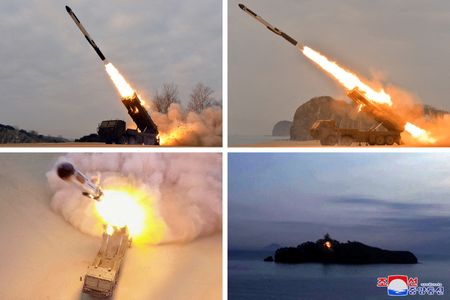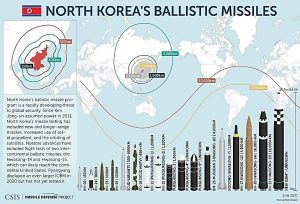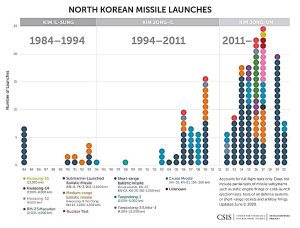
North Korea’s Missiles: Road To Advancement Or Armageddon?

16 March 2022. North Korea (Democratic People’s Republic of Korea – DPRK) caused a shudder with the alleged launch of a ballistic missile (BM) from its international airport at Sunan, leading to opinions that Kim Jong-Un was ‘courting disaster’ by using civilian airport facilities as a launch site. Global concern was further exacerbated when the missile exploded above Pyongyang, leading debris to fall perilously close to habitation.

Purported Television Grab of the Launch: Source -ndtv.com
27 February/ 05 March 2022. DPRK carried out two ‘rocket launches’, claimed to test ‘carrier vehicle’ capability for reconnaissance satellites. However, the US opined that both tests were used to validate an Intercontinental BM (ICBM) being developed, even though achieved ranges were 300 Km/270 Km. The reference was to the Hwasong series of ICBM.
28 September 2021. DPRK test-fired a claimed hypersonic glide vehicle (HGV- probably the Hwasong-8 Missile), which allegedly flew at Mach 10 and hit its target in the Sea of Japan. This generated further concern that the country was poised to join a handful of Nations currently delving into HGV technology (read more @ https://chanakyaforum.com/hypersonic-weapons-new-sprint-kings-in-strategic-weapons-race/).

North Korea Testing a ‘Hypersonic Missile’:Source-nbc12.com
These developments establish that DPRK is striving to be a world-beater in strategic missile advancement, with a likely two-fold aim: as a strategic deterrent (if not a threat) to US and the Western world and a means of generating revenue by way of missile/technology sales to other countries. It must be remembered that DPRK is neither a signatory to the Missile Technology Control Regime (MTCR) nor the Hague Code of Conduct against Ballistic Missile Proliferation (HCOC) and is therefore not governed by their strictures. Such doggedness from a small country whose GDP ranks 200th in the world (IMF 2019), definitely merits an examination of the broad contours of their unique missile program.
Contours of the North Korean Missile Program (NKMP)
Nuclear weapon capabilities are a function of warhead yield, capabilities of the missile (vector) and survivability. As per open-source inputs, NK has conducted six nuclear tests between 2006 and 2017, with estimated yields from 0.7 to 280 Kilotons. Further profiling of DPRK’s nuclear program is beyond the scope of this article, which will concentrate on development of vectors under the NKMP.
The NKMP is characterised by specific advancements spanning missile procurement from other countries, development of indigenous technology for land-based ballistic missile production and onto the contemporary period, wherein the NKMP is churning out strategic missiles capable of being launched from multiple domains.
The Initial Period (1960-1980)
The NKMP owes its genesis to the fallout of the Korean War (1950-53), which saw Russia and China aiding DPRK and the United Nations (UN) with US as the key participant aiding South Korea. The post-war period witnessed enmity against the US firmly entrenched within DPRK’s leadership, then under Kim Il Sung.
While the early 1960s saw ex-import procurement of conventional weapons, it was in 1965 that the seeds for the NKMP were sown, when Kim Il Sung was driven by the conviction that in the absence of guaranteed aid from the Soviet Union and China, indigenous BM technology was the only means to deter the US from entering into/aiding a conflict against DPRK. Training/development of expertise commenced simultaneously, with DPRK setting aside approximately one-third of its budget towards development of military capability (compare this to the defence budget allocation of 20% by US in 2021)!
In September 1971, DPRK inked an agreement with China to acquire, develop and produce BM, in addition to other weapon systems. This cooperation, however, only saw fructification in the late 1970s, when missile engineers from DPRK participated in the joint development of China’s Dong-Feng (DF)-61 liquid-fuelled BM.
Between 1970 and 1980, DPRK embarked on a number of ‘reverse-engineering’ programs, relying on transfer of hardware/technology from the Soviet Union (including the short-range, liquid-fuelled Scud-B Missiles) and China, among others. Interestingly, DPRK is reliably known to have procured among its first Scud-B missiles from Egypt in the late 1970s, as a gesture for assistance rendered in the 1973 Yom-Kippur War against Israel.
The Interim Period (1980-1990)
This period saw consolidation of the indigenous NKMP. The ‘reverse-engineering’ process included, among other facilities, construction of the Musudan-Ri Launch Facility (MRLF), on a peninsula jutting out into the Sea of Japan. By 1984, DPRK had developed/tested the Hwasong-5, an indigenous version of the Scud-B. The option of missile development as a revenue-generating enterprise fructified in 1985, when an agreement was inked with Iran for financial assistance for missile development/production, in exchange for purchase of DPRK missiles. The deal proved beneficial as use of these missiles in the Iran-Iraq war provided vital data inputs, thus saving the North Koreans from extensive flight-testing efforts! The Hwasong-5 entered series production in 1987, followed by the Hwasong-6 (reverse-engineered nuclear-capable Scud-C, with an improved range of 500 Km). The late 1980s saw commencement of the Nodong (Hwasong-7) Missile Program, focussing on improvement of the Scud into a nuclear-capable, road-mobile BM with range just short of 1500 Km. This signified achievement of regional capability and put Japan (including US bases) and South Korea within range! This period witnessed commercialisation of the NKMP, with technology transfers/turnkey missile production offered to countries in the Middle East. Such collaboration has featured throughout the NKMP, including alleged illicit BM exports to Myanmar in 2017-18.

MRLF: Source-nuke.fas.org
Contemporary Period (1990 to Date)
This period has seen North Korea grow into a significant missile-developing Nation, with multi-domain capability. The Nodong was successfully flight-tested in 1993 and deployed in 1995, probably as an overt move to demonstrate enhanced deterrence capability.
The next venture of the NKMP was the Taepodong-1, a three-stage technology-demonstrator with Nodong as the first-stage, Hwasong as the second-stage and a newly developed, solid-fuelled third-stage, launched on 31 August 1998 from the MRLF. DPRK claimed that the rocket was a space-launch vehicle (SLV) for NK’s first Low-Earth Orbit (LEO) satellite. The launch, however failed at the third-stage, which did not ignite. Interestingly, the rocket, suspected to indicate ICBM development, overflew Japan, with the second/third stages falling into the Pacific Ocean. While the launch was unsuccessful (though DPRK claimed otherwise), the flight path established the capability to engage Guam and areas East of Japan’s’ territorial waters. In response to this, the United Nations Security Council (UNSC) unanimously adopted Resolution 1695, demanding that DPRK suspend all missile-related activities, with an embargo on transfer of missile-related materials/technologies to the Hermit Kingdom.
In 2003, US satellite imagery detected development activities related to the Musudan BM-25, a road-mobile, liquid-fuelled Intermediate-Range BM (IRBM) with a range of 2,500-4,000 Km, developed from the Soviet R-27 Submarine-Launched BM (SLBM). The Musudan was tested six times between April and June 2016, failing on the first five launches. The rapid frequency of testing, without allowing for time to address product improvement issues between launches, strongly indicated that these tests were intended to deliver a political message of enhanced BM development and manufacturing capability- another milestone in the deterrence conundrum for DPRK. The sixth test demonstrated a range of 400 Km and a lofted trajectory with an apogee (vertex) of 1400 Km, thus hinting at successful re-entry capability, while avoiding controversy by keeping the point of impact within DPRK’s regional space. Beginning 2016 till early 2017, DPRK carried out two series of rapid-succession testing of extended-range (ER) Scud BM into the Sea of Japan. Analysts opined that the latter series was intended to simulate a (nuclear?) strike against the US Base at Iwakuni, Japan!
Concurrently, in April 2009, in continuance of ‘ICBM’ development, DPRK commenced developmental test series of the larger Unha-2 Rocket (Taepodong-2) SLV with a launch to place a satellite in LEO. No orbit was however detected. A second launch was attempted from the Sohae Satellite Launching Station (SSLS) on the Southwestern coast, in April 2012, with a larger payload capability, which yielded similar results. The improved Unha-3 was subsequently tested in December 2012/February 2016. A new ICBM was displayed shortly after the February 2016 test, which appeared to be the Hwasong-13, mounted on Transporter-Erector-Launchers (TEL) of Chinese origin.
The NKMP’s solid-fuel booster capabilities were underscored when on 12 February 2017, during Japanese Premier Shinzo Abe’s visit to the US, the new Pukguksong-2 BM (a land-based version of its SLBM predecessor) was launched into the Sea of Japan, at a range of 500 Km. The missile, with likely technological assistance from Iran, was tested using a cold-launch canister system from a tracked TEL, thus demonstrating minimal requirement of logistics for launch. The SLBM itself, was previously test-fired on 10 May 2015 from a submerged barge. DPRK has conducted six SLBM tests to date including that of a solid-fuelled SLBM, tested in April 2016 for an extrapolated range of 1000 Km (profiled in detail @ https://chanakyaforum.com/factbox-north-koreas-submarine-launched-missiles/ ).
On 08 June 2017, DPRK test-fired a Kumsong-3 Coastal-Defence Cruise Missile (CM). NK’s first proclaimed ICBM, the Hwasong-14-a road-mobile, TEL-mounted, liquid-fuelled, two-stage vector, capable of delivering a 500 Kg warhead, was launched on 04 July 2017. Based on its 2800 Km apogee, the missile demonstrated an extrapolated range of 6700-8000 Km, thus making it a true ICBM. A second launch four weeks later showed an enhanced extrapolated range of 10,000 Km. The improved Hwasong-15 ICBM, with a blunter nose, suggestive of larger/multiple-warhead capability, demonstrated a night-launch on 29 November 2017, with an apogee of 4417 km and an extrapolated range of 13,000 Km, thus extending DPRK’s reach to the entire continental US. This prompted DPRK state media to claim that the country had “finally realized the great historic cause of completing the State Nuclear Force”!

Graphic of Hwasong-15 ICBM: Source-Wikimedia
On 12 June 2018, at a summit meeting with US President Donald Trump in Singapore, Kim Jong-Un pledged to ‘work towards denuclearisation’ and refrain from ICBM testing. This held good till May 2019, when DPRK tested three Short Range BMs (SRBMs) in quick succession, including one that resembled the Russian Iskander Hypersonic SRBM. The year witnessed 13 tests, majorly involving the solid-fuelled KN-25 SRBM (four of which can be mounted on a single TEL) and the nuclear-capable Pukguksong-3 (KN-26) SLBM. Notably, these ranges did not violate the commitments of the Singapore summit, but confirmed DPRK’s pursuance of its missile program, including a demonstrated capability of subjecting South Korea to barrages of the KN-25 from its TELs!
The military parade to mark the 75th founding anniversary of the DPRK Workers’ Party in October 2020 witnessed the ER Pukguksong 4A SLBM and a massive liquid-fuelled ICBM (Hwasong-16/17?) on its TEL, which at a length of 25m, is 15% longer than the Hwasong-15, suggesting a greater range and payload.

Screen-grab of the Hwasong-16(17?) ICBM:Source-iiss.org
2021-22 has seen the NKMP progressing unabated, with demonstration of new variants of BM/CM/HGV technology, as detailed above. Kim Jong-Un elucidated his ambitions for further development of CM & tactical nuclear weapons at the Congress of the Workers’ Party of Korea meet in January 2021. On 22 January & 21 March 2021, DPRK launched an Anti-Ship-Cruise-Missile (ASCM) (KN-27). A long-range CM, likely a Land-Attack CM (LACM) was test-fired on 11/12 September, hitting its target at 1500 Km. DPRK has so far conducted close to 10 missile tests in 2022! This has exacerbated DPRK’s missile brinkmanship.

Launch of LACM: Source-iiss.org
Further demonstrations of the NKMP can be expected in the build-up to the 110th birth anniversary of Kim Il Sung, on 15 April 2022. This could include renewed interest in ICBM testing, as indicated by Kim Jong-Un’s visits to SSLS and his directions to expand existing facilities, as part of his five-year military modernisation plan.

Source- csis.org

Source- csis.org
Conclusion
The rapid developments, demonstration and testing (usually in that order) of vectors under the NKMP signify the high priority accorded by the country to its missile program. Existing nuclear powers including India would need to closely monitor the progress/contours of the NKMP to ensure that at no point is an impasse reached where the Hermit Kingdom gets the opportunity to flex its nuclear muscle while leaving the rest of the world with no easy option towards resolution.
Disclaimer
The opinions expressed in this article are the author’s own and do not reflect the views of Chanakya Forum. All information provided in this article including timeliness, completeness, accuracy, suitability or validity of information referenced therein, is the sole responsibility of the author. www.chanakyaforum.com does not assume any responsibility for the same.
Chanakya Forum is now on . Click here to join our channel (@ChanakyaForum) and stay updated with the latest headlines and articles.
Important
We work round the clock to bring you the finest articles and updates from around the world. There is a team that works tirelessly to ensure that you have a seamless reading experience. But all this costs money. Please support us so that we keep doing what we do best. Happy Reading
Support Us





















POST COMMENTS (0)